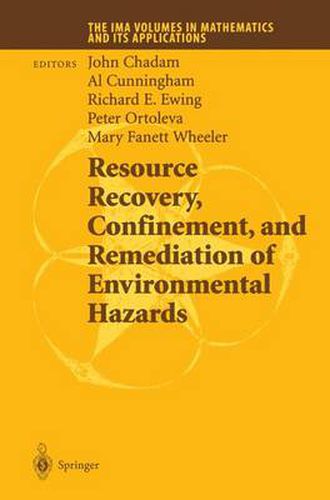Readings Newsletter
Become a Readings Member to make your shopping experience even easier.
Sign in or sign up for free!
You’re not far away from qualifying for FREE standard shipping within Australia
You’ve qualified for FREE standard shipping within Australia
The cart is loading…






This title is printed to order. This book may have been self-published. If so, we cannot guarantee the quality of the content. In the main most books will have gone through the editing process however some may not. We therefore suggest that you be aware of this before ordering this book. If in doubt check either the author or publisher’s details as we are unable to accept any returns unless they are faulty. Please contact us if you have any questions.
This IMA Volume in Mathematics and its Applications RESOURCE RECOVERY, CONFINEMENT, AND REMEDIATION OF ENVIRONMENTAL HAZARDS contains papers presented at two successful one-week workshops: Confine ment and Remediation of Environmental Hazards held on January 15-19, 2000 and Resource Recovery, February 9-13, 2000. Both workshops were integral parts of the IMA annual program on Mathematics in Reactive Flow and Transport Phenomena, 1999-2000. We would like to thank John Chadam (University of Pittsburgh), Al Cunningham (Montana State Uni versity), Richard E. Ewing (Texas A&M University), Peter Ortoleva (In diana University), and Mary Fanett Wheeler (TICAM, The University of Texas at Austin) for their excellent work as organizers of the meetings and for editing the proceedings. We take this opportunity to thank the National Science Foundation for their support of the IMA. Series Editors Douglas N. Arnold, Director of the IMA Fadil Santosa, Deputy Director of the IMA v PREFACE Advances in resource recovery, and confinement/remediation of envi ronmental hazards requires a coordinated, interdisciplinary effort involving mathematicians, scientists and engineers. The intent of this collection of papers is to summarize recent theoretical, computational, and experimen tal advances in the theory of phenomena in porous media, with the intent to identify similarities and differences concerning applications related to both resource recovery and confinement and remediation of environmental hazards.
$9.00 standard shipping within Australia
FREE standard shipping within Australia for orders over $100.00
Express & International shipping calculated at checkout
This title is printed to order. This book may have been self-published. If so, we cannot guarantee the quality of the content. In the main most books will have gone through the editing process however some may not. We therefore suggest that you be aware of this before ordering this book. If in doubt check either the author or publisher’s details as we are unable to accept any returns unless they are faulty. Please contact us if you have any questions.
This IMA Volume in Mathematics and its Applications RESOURCE RECOVERY, CONFINEMENT, AND REMEDIATION OF ENVIRONMENTAL HAZARDS contains papers presented at two successful one-week workshops: Confine ment and Remediation of Environmental Hazards held on January 15-19, 2000 and Resource Recovery, February 9-13, 2000. Both workshops were integral parts of the IMA annual program on Mathematics in Reactive Flow and Transport Phenomena, 1999-2000. We would like to thank John Chadam (University of Pittsburgh), Al Cunningham (Montana State Uni versity), Richard E. Ewing (Texas A&M University), Peter Ortoleva (In diana University), and Mary Fanett Wheeler (TICAM, The University of Texas at Austin) for their excellent work as organizers of the meetings and for editing the proceedings. We take this opportunity to thank the National Science Foundation for their support of the IMA. Series Editors Douglas N. Arnold, Director of the IMA Fadil Santosa, Deputy Director of the IMA v PREFACE Advances in resource recovery, and confinement/remediation of envi ronmental hazards requires a coordinated, interdisciplinary effort involving mathematicians, scientists and engineers. The intent of this collection of papers is to summarize recent theoretical, computational, and experimen tal advances in the theory of phenomena in porous media, with the intent to identify similarities and differences concerning applications related to both resource recovery and confinement and remediation of environmental hazards.